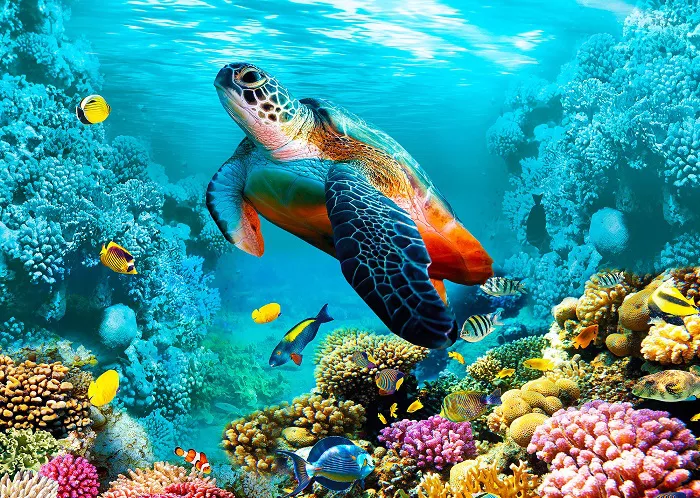Today marks World Sea Turtle Day, an international observance dedicated to celebrating sea turtles and raising awareness about the critical need to protect marine wildlife. The date honors the birthday of Dr. Archie Carr, a pioneering sea turtle biologist and founder of the Sea Turtle Conservancy, whose legacy continues to inspire conservation efforts worldwide.
Despite ongoing efforts, marine species face increasing dangers, notably from plastic pollution. A striking campaign highlighting this issue gained momentum after a male Ridley sea turtle was discovered with a plastic straw lodged in its nostril, severely hindering its ability to breathe. This incident has become a powerful symbol of the broader environmental crisis affecting oceans globally.
Diverse Habitats Across Species
Sea turtles inhabit various regions, predominantly in warmer tropical waters, but their preferences for specific habitats differ by species. Loggerhead turtles boast a worldwide presence, while leatherbacks have the broadest oceanic distribution. In contrast, flatback turtles remain largely confined to Australian coastal waters, and olive ridleys frequent coastal zones near Costa Rica, Mexico, and India, where abundant nesting sites support their populations.
Other species display more specialized habitat choices. Kemp’s ridley turtles favor shallow, muddy or sandy bottoms rich in crustaceans, primarily in the Gulf of Mexico, occasionally venturing to European waters. Hawksbill turtles thrive in tropical regions across the central Atlantic and Indo-Pacific, relying on diverse habitats including coral reefs for different life stages. Green sea turtles typically occupy protected shores and bays along the western coasts of the Americas.
Varied Diets Reflect Adaptations
Sea turtles exhibit a wide range of dietary habits, from omnivory to carnivory and herbivory, linked to species-specific jaw structures. Australian flatbacks and olive ridleys, both omnivores, consume a mixture of plants, fish, crabs, and jellyfish. Carnivorous species such as loggerheads, leatherbacks, and Kemp’s ridleys show specialized feeding adaptations: loggerheads can crush hard shells, leatherbacks primarily feed on jellyfish, and Kemp’s ridleys use hooked jaws to prey on blue crabs.
The green sea turtle stands out as the sole herbivore, equipped with serrated beaks to grind sea vegetation. Hawksbill turtles, meanwhile, are classified as “spongivores” due to their near-exclusive diet of marine sponges.
The Rare Kemp’s Ridley and Nesting Behaviors
Among the seven sea turtle species, the Kemp’s ridley is the smallest and rarest, measuring about two feet in length and weighing between 70 and 100 pounds. Recognizable by their nearly circular shells, these critically endangered turtles have experienced significant population declines since the early 20th century.
Kemp’s ridleys exhibit unique nesting behavior, participating in “arribadas,” massive synchronized nesting events where large groups come ashore simultaneously to lay eggs. This strategy enhances hatchling survival by overwhelming predators. Notably, Kemp’s ridleys often nest during daylight hours, a rarity among sea turtles. Strong ocean currents occasionally carry them from their native Gulf of Mexico and North Atlantic habitats as far as Europe.
Respiration and Diving Capabilities
Contrary to common misconceptions, sea turtles cannot breathe underwater. As reptiles, they lack gills and must surface frequently for air, especially during active swimming, which demands high energy. Typically, sea turtles surface every few minutes when active but can hold their breath for up to two hours while resting or inactive.
Impact of Climate Change on Reproduction
Sea turtle reproduction is highly sensitive to environmental conditions. Females lay multiple clutches of approximately 100 to 125 eggs, burying them in sand where incubation temperature determines hatchling sex. Warmer sand temperatures (29.5–34°C) produce predominantly female hatchlings, while cooler temperatures (24–29.5°C) yield more males. Fluctuating temperatures result in mixed sexes.
Rising global temperatures have skewed sex ratios toward females, posing long-term risks to population stability. Additionally, microplastic pollution in nesting sands exacerbates heating, further threatening balanced hatchling sex ratios. Recent studies found microplastics embedded in nesting sites, such as those at Qilianyu in the South China Sea, underscoring this emerging hazard.
Ongoing Conservation and Challenges
Global conservation initiatives focusing on habitat protection and nest safeguarding have yielded positive results for many sea turtle populations. However, several species, especially leatherbacks, remain endangered. Continuous research and sustained conservation efforts are essential to ensure their survival.
A decade after plastic straws became a focal point in marine conservation discourse, awareness and action must intensify to address ongoing threats. Supporting organizations dedicated to sea turtle preservation and combating plastic pollution remains critical to securing the future of these marine icons.


